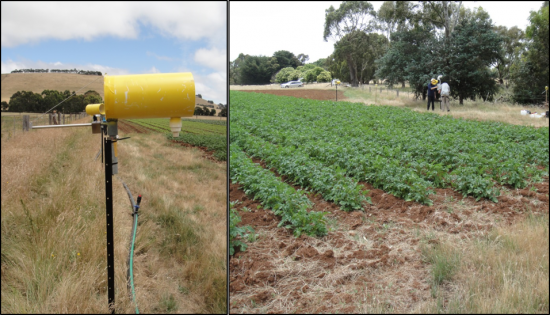The Plant Biosecurity Cooperative Research Centre (PBCRC), with funding support from the Horticulture Innovation fund, developed a rapid technique for the detection of Tomato potato psyllid (TPP). These metabarcoding experimental protocols (known as bulk DNA analysis) are a new alternative approach to the current relatively expensive, low throughput methods of insect surveillance in use, such as yellow sticky traps, which require expert microscopic examination to identify trapped insects.
The urgent need for improvements to monitoring and surveillance of TPP with an emphasis on natural dispersal pathways was recognised by the Potato Processors Association Australia (PPAA) and AUSVEG. This project was developed as a direct consequence of this need, bringing together new molecular technologies, knowledge of wind dispersal of pests, and current trapping strategies, to improve surveillance for this pest.
Presentation: rapid technique for identification of exotic Tomato Potato Psyllid (TPP) PDF opens in new window (Note: this document does not meet WCAG 2.0 accessibility guidelines)
 TPP field collection point in potato farm
TPP field collection point in potato farm
Background
Potatoes are the leading vegetable crop grown in Australia, with annual production valued at over $620M and Victoria production estimated at $137M per year (2015-2020, Victoria Potato Industry Strategic Plan). This industry is now under threat from a devastating pest that has recently arrived in New Zealand and Western Australia, the tomato potato psyllid, Bactericera cockerelli. Infestation by this sap sucking insect causes stunting and stem death, and vectors the bacterium associated with zebra chip disease of potatoes (Candidatus Liberibacter solanacearum), which renders produce unsellable on domestic and international markets. The Australian Potato Industry Biosecurity Plan rates the overall risk profile from TPP in Australia as extreme, with the cost of an eradication strategy estimated at $1.2 billion (ABARES 2012-13).
The recent incursion of TPP in New Zealand caused a significant loss of productivity in commercial potato crops, and with only 2,000 km separating New Zealand from the Australian mainland, there is a high threat of an incursion. TPP has also recently been detected within Australia, in Western Australia, but is so far not known from the eastern states. TPP can be dispersed on wind currents, and the Australian Potato industry has become increasingly concerned that this pest may enter the country via wind corridors.
Summary
Insect trapping and surveillance is central to national plant biosecurity. Surveillance traps are generally left out for many weeks, during which time they can catch a large number and variety of insects. The necessary time spent identifying insects in bulk trap catches is a major limitation to national pest surveillance, and accuracy of identification can be affected by degradation of insects whilst in the trap. Metabarcoding is a molecular identification method that can be used to simultaneously detect multiple insect species in bulk samples, through high throughput DNA sequencing. During this one-year HIF funded project we developed metabarcoding experimental protocols (known as bulk DNA analysis) for the detection of Tomato potato psyllid (TPP), Bactericera cockerelli, within mixed-species insect samples. Bulk DNA analysis for TPP was developed as an example of how to apply this new technology to surveillance of an exotic insect pest species currently not present in eastern Australia.
Preservation of DNA is crucial to bulk DNA analysis. We conducted specimen preservation experiments to confirm propylene glycol as an effective insect DNA preservative under temperature conditions likely to be experienced in field traps. To enable insects to be identified by their DNA sequences, we then characterised DNA sequence variation of TPP, seven other species of psyllid and aphid, and developed degenerate PCR primers to amplify three target genes (COI, 12S and 18S) together through multiplex PCR. Mixed-species pools of specimens, consisting of 100 to 1000 insects were examined through metabarcoding to test the limits of detection and quantification for the identification of target insects in bulk pooled samples.
Our results demonstrated accurate bulk DNA diagnostics: samples that did not include the target taxa (negative samples) appeared negative based on the sequence data, while samples with the target taxa (positive samples) produced sequence reads from the target taxa. Additionally, the analysis revealed some degree of quantification: the number of reads obtained per sample appears to be relatively proportional to actual number included. However, there does appear to be a bias towards the detection of TPP. Ten field collected trap samples were also successfully examined using our metabarcoding protocols.
This work clearly demonstrates that metabarcoding methods developed in this study are an effective means to detect and monitor TPP in trap samples, and might even be more sensitive than traditional morphological based methods. Metabarcoding thus provides a powerful new alternative approach to those currently being used for TPP surveillance and monitoring in eastern Australia.